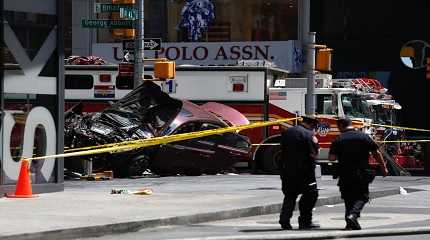
NEW YORK (AP) — For some survivors, the sounds are a part of what still haunts them: People screaming. Car tires screeching. An engine revving.
It was “like somebody just floored it … It was so loud,” Jyll Elsman told a jury on a recent day in a Manhattan courtroom. “That is the last thing that I remember before everything went black.”
When Elsman came to her senses, she desperately searched for her teen daughters only to find a mother’s ultimate nightmare. One of her children was dead and another severely injured — carnage left behind by a rampaging driver who plowed through pedestrians on what began for a Michigan family as a mundane tourist outing in Times Square in 2017.
Elsman’s harrowing story is central to the ongoing trial of Richard Rojas, the man behind the wheel of a maroon Honda Accord that killed Elsman’s daughter and injured more than 20 other people in an alleged attack with a motive that remains elusive. Rojas, 31, has pleaded not guilty to murder, assault and other charges.
Prosecutors are largely relying on the testimony of victims like Elsman to make a case against Rojas that could put him behind bars for decades. His lawyers say he had a mental breakdown that day and had no capacity to understand what he was doing.
At the time, he was someone “suffering from schizophrenia whose mind had deteriorated so much that he lost control,” said defense attorney Enrico DeMarco in opening statements about a client who’s appeared impassive during the proceedings. DeMarco added: “The evidence is going to show he met the criteria for legal insanity.”
Prosecutor Alfred Peterson conceded Rojas had some mental challenges. But Peterson also argued the defendant was a military veteran who had led a mostly normal life and didn’t meet the insanity standard.
“It was impossible for him not to know exactly what was happening,” the prosecutor said.
Experts are slated to address the mental health question later in the trial. For now, that’s left jurors to analyze the prosecution’s case which started with them seeing a selfie flashed on a video screen of Elsman, her daughters Ava and Alyssa, and a family friend seated on the red bleachers in the middle of Times Square moments before tragedy struck.
The group was walking and “just looking around, kind of eyeballing someplace to eat,” when a car mounted the sidewalk, Elsman said. She testified she felt herself getting knocked down by the car, briefly going blank and then pulling herself up to look for her daughters.
The mother found Ava, then 13, on the ground but still alert. She then rushed around to look for Alyssa, who was 18. What she found was devastating.
“I looked at her eyes and I just knew she was dead. They were fixed. They weren’t looking around,” she said. “All I could do was scream.”
Thomas Patterson, an actor on his way to a rehearsal that day, took the witness stand to recall vivid memories of the mayhem.
“I saw somebody being thrown 25 feet into the air, people being knocked around. It was an intense sight,” Patterson said.
On impulse, “I ran after the car,” he said. “I’m not super proud of that. I don’t know what I was thinking.” He said he gathered himself and stopped to call 911.
Michael Elias, a tax lawyer, testified about seeing “bodies flying, pandemonium, people screaming, jumping out of the way.”
The first responders would find a survivor named Wissam Issa, a social worker who testified he felt the full impact of the runaway Honda. Issa said he took a hit on “my whole left side of my face, my whole left side of my body, my back, my arm with the windshield.”
Ava, the younger Elsman daughter, was mowed down in a similar way. She recited her multiple injuries for the jurors: broken ribs, collapsed lung, a compound leg fracture and more harm that kept her off her feet for months.
She said a deeper injury occurred in the hospital, when she asked her mother about what happened to her older sister. She was answered with silence.
Her mother’s “face dropped,” she said. “And with no words, I knew exactly what had happened.”




